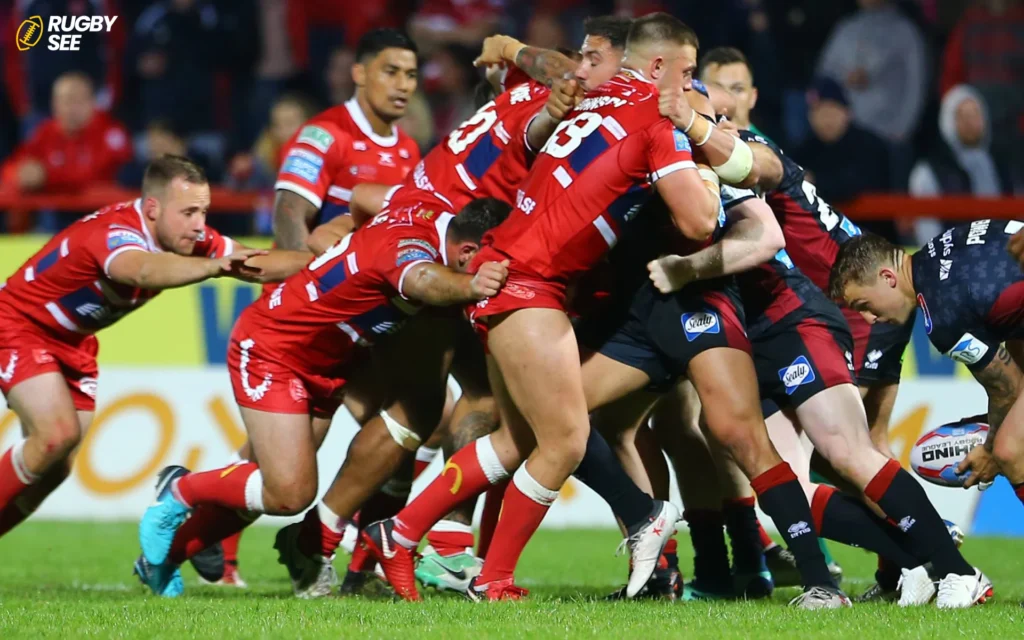In the dynamic and rigorous sport of rugby, the scrum stands out as one of its most iconic and confusing elements, especially for newcomers and spectators. This tight mix of players, heads down and locked together, may at first look like a confusing complex. However, the scrum is a fundamental aspect of rugby, steeped in strategy, skill and tradition. This article from Rugbysee explores the purpose of the scrum in rugby, explains its importance, how it works and how it affects the game.
The Basics of a Rugby Scrum
A scrum is a method of restarting the game in rugby, following minor infringements of the rules, such as a forward pass or a knock-on (when the ball is accidentally propelled forward by a player). It involves eight players from each team, known as the forwards, binding together in three rows and pushing against the opposing team’s similarly arranged eight players.
Strategic Purpose
The primary purpose of a scrum is to ensure fair competition for possession of the ball following a minor infraction. It provides a structured and controlled contest between the two teams, with the team that did not commit the infringement given the advantage of introducing the ball into the scrum. This aspect of competition and fairness is central to the spirit of rugby and if you want to know about invention of Football read When was American football invented.
Safety and Order
The scrum also serves to maintain safety and order on the pitch. By binding the forwards in a scrum, the game effectively removes the largest and strongest players from open play, temporarily reducing the risk of injuries and allowing the smaller, faster players (the backs) more space and opportunity to execute strategic plays.

How Does a Scrum Work?
Understanding the mechanics of a scrum is key to appreciating its importance in rugby. The process is carefully regulated by the laws of the game, with specific roles for each of the eight positions in the scrum, ensuring balance, stability, and fairness.
The Engagement
The scrum formation begins with the front rows of each team binding together tightly. The referee then instructs the teams to engage, at which point the two packs come together in a controlled manner. This engagement must be stable and square, preventing collapses and ensuring player safety.
The Feed
Once the scrum is set, the scrum-half from the team awarded the scrum will roll the ball into the tunnel formed by the two front rows. This is known as the “feed.” The team’s hooker then uses their feet to “hook” the ball back towards their side, aiming to secure possession.
The Contest
While the hooker tries to win the ball, both teams push against each other, trying to gain ground and disrupt the opposition’s control. The team that manages to secure the ball then either passes it out to the backs to continue play or keeps it within the forwards to maintain possession and gain territory.
The Impact of the Scrum on the Game
The scrum has a significant impact on the flow and strategy of a rugby game. It’s not just a test of strength; it’s a complex contest that requires technique, coordination, and strategy.
Territory and Possession
Winning a scrum can provide a critical advantage in terms of territory and possession. A well-executed scrum can set the foundation for attacking plays, allowing a team to build momentum and pressure on the opposition.
Physical and Psychological Battle
The scrum is also a physical and psychological battle, with teams looking to assert dominance early on. A powerful scrum performance can intimidate the opposition and boost the confidence of the team, influencing the overall dynamics of the match.
Skill and Discipline
Executing a successful scrum requires a high level of skill and discipline from the forwards. Each player must understand their role and work in unison with their teammates. This cohesion and technical proficiency are vital, as errors in the scrum can lead to penalties, giving the opposition advantageous positions and opportunities to score.

The Evolution of the Scrum in Rugby
Over the years, the scrum has evolved, reflecting changes in the game’s rules and the physicality of players. Rugby authorities have continually adapted the laws governing scrums to enhance player safety, maintain the contest’s fairness, and ensure the game remains dynamic and spectator-friendly. These adjustments have influenced how teams approach scrummaging, with a greater emphasis on technique and collective strength rather than sheer individual force.
The Role of the Scrum in Player Development
The scrum is also instrumental in player development, particularly for forwards. It teaches players about leverage, balance, and the importance of working as a cohesive unit. The skills and discipline required for scrummaging are applicable across various aspects of rugby, fostering a well-rounded understanding of the game. Young players learn early on that rugby is not just about personal glory but about how effectively they contribute to the team’s objectives, starting with the foundational battle at the scrum.
The Scrum as a Spectacle
For fans and spectators, the scrum is one of the game’s most intriguing spectacles. It’s a moment of anticipation and tension, often leading to pivotal shifts in momentum. The sight of two packs coming together, the battle for possession, and the strategic outcomes of each scrum contribute significantly to the drama and appeal of rugby. This combination of physical prowess, tactical depth, and unpredictability is a key reason why the scrum is a cherished element of the sport and if you want to know about shaving legs in Rugby read Unraveling the Mystery: Why Do Rugby Players Shave Their Legs.
Refereeing and the Scrum
The complexity of the scrum presents unique challenges for referees, who must ensure that it is conducted safely and fairly. They are responsible for monitoring the engagement, the feed, and the behavior of players during the scrum, making split-second decisions that can affect the game’s outcome. This responsibility underscores the importance of experience, knowledge, and positioning for referees, who play a crucial role in maintaining the integrity and safety of the scrum.
The Future of Scrums in Rugby
As rugby continues to evolve, so will the role and nature of the scrum. Innovations in training, player conditioning, and game strategy may further change how scrums are conducted and their impact on the game. Rugby authorities remain committed to improving player welfare, and this will likely shape future adjustments to scrum laws. Additionally, the ongoing analysis of scrum-related injuries and advances in sports science will influence how scrums are integrated into the sport, ensuring that they remain a vital, yet safe, component of rugby.

Educational Resources and Training
To support the development of safe and effective scrum techniques, rugby organizations worldwide offer educational resources and training programs for players and coaches. These initiatives aim to enhance understanding of the scrum, promote best practices, and reduce the risk of injury. By investing in education and training, the rugby community works to preserve the scrum’s essence while adapting to the modern demands of the sport.
The scrum is more than just a method of restarting play; it’s a cornerstone of rugby’s tactical and physical challenge. It embodies the sport’s core values of fairness, teamwork, and respect. Through the scrum, rugby showcases its unique blend of strength, skill, and strategy, making it a pivotal point of interest and excitement in the game.
Understanding the intricacies and purpose of the scrum enhances the appreciation of rugby as a sport. It highlights the complexity beneath the surface of what might initially appear as a mere contest of strength. The scrum is a vital aspect of rugby, encapsulating the challenge, camaraderie, and spirit that define the game.










